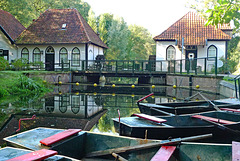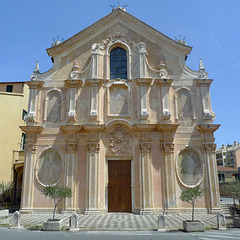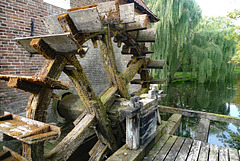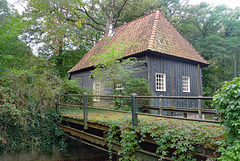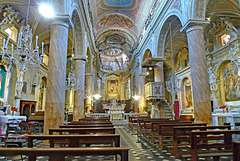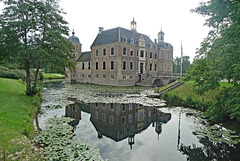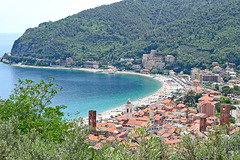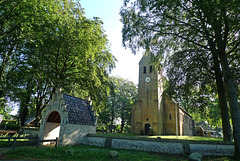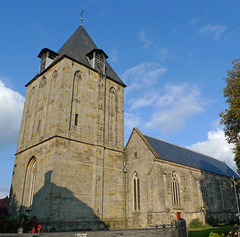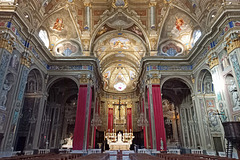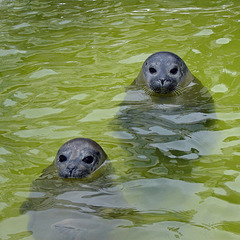Jaap van 't Veen's photos
Nederland - Winterswijk, Den Helder
| |
|
|
|
Watermill Den Helder is a former double undershot corn and oil watermill on the course of the Boven-Slinge near Winterswijk. The watermill is a Dutch national monument.
The earliest known mention of the mill dates back to 1303 when it was part of Havezate Plekenpol (a manor or fortified farmhouse). For many years, the mill was called Plekenpolsemolen . At the end of the 19th century, the mill came into the possession of "Jan Helder" and was named Den Helder ever since.
In 1922, the mill was sold by auction to “Derk Jan Berenschot”, owner of another water mill nearby. He bought the mills to eliminate competition for his own mill. From 1923, therefore, the mills are no longer in operation. An ice cream parlour was established in the oil mill and the corn mill became a cafe after a conversion in 1934.
From the 1970s in the last century, the water mills slowly fell into disrepair. A thorough restoration was completed in 2016 and the watermill is once again operating, albeit for electricity generation. The two buildings have since been used as homes.
Italy - Finale Ligure, Chiesa di Santa Maria di Fi…
| |
|
|
|
The Abbey of Santa Maria di Finalpia is an ancient centre of Catholic worship in Finale Ligure, located in the hamlet of Finalpia on the banks of the Sciusa stream. The church and the Benedictine abbey of Santa Maria constitute one of the most important monastic centers in Liguria in religious and artistic terms.
The origins of the abbey date back to the 12th century, when the presence of a small chapel held by the Abbey of San Quintino di Spigno in the area is mentioned. The current monastery building is dating back to the 16th century. The church was erected only between 1724 and 1728, based on a design by Girolamo Veneziano.
The church has an interesting façade in Baroque style with stuccoes, columns and round windows. The importance of the medieval church is testified by the majestic bell tower. The interior is embellished with numerous works of art of a classical religious nature, dating back to the 14th-20th centuries.
Nederland - Borculo, De Olliemölle
| |
|
|
|
De Olliemölle consists of two separate water wheel mills. The one on the left was formerly an oil mill and was changed to a flour mill in 1920. The mill on the righthand side is a corn- and hulling mill.
The mills and their predecessors have traditionally belonged to Heerlijkheid Borculo , which came into the possession of the Van Bronckhorst family at the end of the 14th century. Borculo came into the possession of Stadholder Willem V van Oranje via inheritance in 1777.
In 1812, during the era of the French Empire, the complex was sold at a public auction. Around 1875, the right-hand mill building housed a chicory factory, which burned down in 1880 but was rebuilt a year later.
On 10 August 1925, a tornado destroyed much of Borculo. Damage at the water mills was limited: all the roof tiles were gone but the rest remained intact.
In 1957, the Borculo municipality came into possession of the entire mill complex and had it restored in 1966. At the end of 2007, both mill buildings were sold. The new owners established catering establishments in both buildings. De Olliemölle is located in the heart of Borculo on a side brench of the river Berkel.
Nederland - Eibergen, Mallumsche Molen
| |
|
|
|
The Mallumsche Molen is a breastshot mill on the Berkel. A predecessor of the current mill is mentioned as early as 1424. In the 17th century, there were two mills on both banks of the river Berkel: a corn and a paper mill. In the 18th century, there is talk of a corn and oil mill. The corn mill, which burned down in 1746, was rebuilt two years later. The oil mill also burned down in 1755 and was rebuilt, but was demolished in 1917.
The corn mill remained in operation until 1943 and became the property of the foundation De Mallumsche Molen in 1948 (since 2004 Stichting Eibergse Molens). This foundation started restoration that year; thirty years later, the mill was restored again.
The Mallumsche Molen almost always has sufficient water and is still regularly used by volunteer millers.
Italy - Finale Ligure, Basilica di S. Giovanni Bat…
| |
|
|
|
The Basilica di S. Giovanni Battista (Basilica of Saint John the Baptist) is located in the center of Finale Ligure. It is considered being one of the most beautiful Baroque churches in the region. The construction of the church started in 1619; fifty-five years the church was inaugurated.
The design is usually attributed to Gian Lorenzo Bernini, but most probably designed by local architects, who did work in Bernini's style. The façade, rich in artistic emblems and stained-glass windows, is the work of a local architect and was completed in 1762. The dome of the basilica has a height of 24 meters.
The interior is characterized by a great harmony and simplicity of proportions. The central nave is separated from the two aisles by two rows of paired columns. Twelve very rich chapels - decorated with architectural motifs - are situated in the two aisles. The high altar - built in 1767 - is inlaid with polychrome marbles.
Nederland - Watermolen van Ruurlo
| |
|
|
|
The two buildings of the Watermolen van Ruurlo (Ruurlo water mill) are dating back from 1786. Until about 1830, the double water mill was in use. On one side an oil mill, on the other a flour mill. They are now somewhat hidden in the woods - next to Ruurlo Castle - on the old Ruurlose Beek. Presumably, there was already a water mill on this spot in the mid-16th century. Between the two buildings is a bridge with an iron barrage from around 1840
The water wheels have disappeared over time and the mill is also no longer in operation as a water mill. This is partly because it was feared that the mill would draw too much water from the moat of Ruurlo Castle. On the other hand, the owners of one of the buildings do not want to cooperate with the plans to restore and reinstate the watermill.
Italy - Noli, Cattedrale di San Pietro
| |
|
|
|
The Baroque style Cattedrale di SanPietro (Cathedral of San Pietro) dates back to the 13th century, but in the first version it was a small chapel named after San Pietro. After being chosen as the cathedral of the town diocese in 1572, it was renovated and enlarged, as it looks like nowadays; but some signs of the original building are still visible on the facade and on the right side of the church.
The main treasure inside the cathedral is a Roman sarcophagus in polychrome marble known as “Sant'Eugenio's Ark”, because it was used as the patron saint's relics. The current aspect of this sarcophagus is the result of some restorations made between the 15th and the 16th centuries. Also noteworthy are the bishop's chair in carved walnut wood , the pulpit and a processional case in polychrome wood.
Nederland - Kasteel Ruurlo
| |
|
|
|
The history of Kasteel Ruurlo or Huis Ruurlo (Ruurlo Castle) is dating back to the beginning of the 14th century, when it was first mentioned in the archives as a property of Graaf Reinhoud I van Gelre . The castle was first inhabited bij the family Van Roderlo, after which it is most probably named.
Kasteel Ruurlo was several times renovated and expanded and shows architecture from five centuries. Its original lay-out is alomost inatct. Its current appearance dates from the 15th and 17th century.
In the 15th century, it passed into the hands of Jacob van Heeckeren, the founder of the noble and distinguished family of Van Heeckeren. Castle and estate were owned and managed by the family for more than five centuries through to 1977. During World War II the castle was used as the headquarters of the German General Staff. In 1977 it passed into the hands of the municipality of Ruurlo and was used as town hall till 2005.
Hans Melchers, a Dutch art collector, bought Kasteel Ruurlo in 2013. Four years later - after a thorough restoration - it became part of MORE (a museum for Dutch MOdern REalism) with paintings of famous painter Carel Willink and some special creations by the Chinese-Dutch fashion designer Fong Leng.
Italy - Noli
| |
|
|
|
Noli - probably founded by the ancient Greeks - is located along a beautiful Ligurian bay, and borders Bergeggi to the east and Capo Noli to the west. The location of the village was an important factor in trade and Noli flourished. It was the capital of the Maritime Republic of the same name between 1193 and 1797, when it celebrated its heyday. Noli played an important role in the defence of the Ligurian coast against attacks.
The historic centre of Noli has a maze of small narrow streets surrounded by medieval towers and colourful houses. The most interesting buildings are dating back to the 13th century; among them the Torre del Comune, the Palazzo del Comune (town hall) and the cathedral. The town is surrounded by steep hills and one can enjoy beautiful views over the roofs of the village. For instance from the old Castello di Monte Ursino (main image).
Noli belongs to il borghi pui bella d'Italia (the most beautiful villages in Italy).
Italy - Varigotti
| |
|
|
|
Varigotti - once a fishing village and nowadays a seaside resort, is characterized by bright coloured houseswith their ‘feet’ in the sand. Due to its beaches the villages is a popular tourist destination. Varigotti is also known as “Saracen hamlet”.
Varigotti has experienced varied dominations over the centuries. In late antiquity times, it was known as Varicottis. In 643, when it was home to a Byzantine fortification, it was destroyed by the Lombard king Rothari. Later it suffered from Saracen raids, and in the 12th century it was contended between the marquisses of Noli and the Del Carretto family. Later it was a possession of the Republic of Genoa, and became an autonomous commune after the French Revolution.
Once an independent municipality, in 1927 it became part of Finale Ligure.
Nederland - De Alde Feanen
| |
|
|
|
Nationaal Park De Alde Feanen (meaning: The Old Fenlands) is one of the twenty national parks in the Netherlands. The park is located in the heart of the province of Friesland . De Alde Feanen is a unique area; a result of the peat excavations, which were carried out here in the past. Nowadays it is an area of freshwater lakes, reed lands, forested marshland and grasslands.
The park contains approximately 425 hectares of surface water, about the same as 650 football pitches! It consists of ditches, canals, peat pit ponds, other ponds and lakes. The reed beds in De Alde Feanen cover a significant part of the total surface, with extensive belts occurring alongside the open waters of lakes and smaller water bodies. In the area at least 450 plant species and 100 bird species can be found.
Since 1934 De Alde Feanen is owned by It Fryske Gea , a provincial nature protection organisation in the province of Friesland. The park can be visited free of charge.
Nederland - Oldeberkoop, Bonifatiuskerk
| |
|
|
|
The Bonifatiuskerk (Saint Boniface Church) is one of the oldest churches in southeast of the province of Friesland . The church building is the historical centre of the village. At its foundation the church was dedicated to Bonifatius . In a document from 1553 the church is referred to as the Parish Church of “H. Vitus te Antiqua Bercoop in Stellingwerff”. The construction of the oldest parts of the church was probably completed around the year 1125.
The old churchyard of the church is surrounded by a rustic ring wall, made of Frisian bricks. The ring wall probably dates from the beginning of the 17th century, the same period in which the tower was restored after earlier destruction. The wall was intended to separate the consecrated soil around the church from the unconsecrated ground outside.
Old prints show some entrance gates with stepped gables; probability there were four of them in total, one for each cardinal direction. The western (main image) gate was reconstructed in 2012.
After the reformation, the church was given a Protestant signature. The complex ofchurch, churchyard and ring wall is a national monument owned by the local protestant congregation.
Nederland - Zeeland, Oosterscheldekering
| |
|
|
|
The Oosterscheldekering (Eastern Scheldt Barrier) is the largest and best known of the Delta Works (a series of dams and storm surge barriers, designed to protect the Netherlands from flooding from the North Sea).
The barrier is a 9 km long structure which seals off the Oosterschelde if there is a threat of flooding. The Oosterscheldekering Barrier connects the islands of Schouwen-Duiveland and Noord-Beveland in the province of Zeeland and was built between 1976 and 1986. It is the largest storm surge barrier in the Netherlands.
The Oosterscheldekering has 65 colossal pillars, separated by sluice gates that are roughly 42 meters wide and 6 to 12 meters high, each weighing between 260 and 480 tonnes. It is designed to withstand a flood that is statistically unlikely to occur more than once in 4,000 years.
The barrier will be closed if the water level of the North Sea is predicted to rise to more than 3 meters above “Normal Amsterdam Level”. At the press of a button, all 62 sluice gates are lowered and it takes 82 minutes for them all to close completely.
Nederland - Delden, Oude Blasius
| |
|
|
|
The reformed old church in Delden - originally dedicated to St. Blasius - is an example of church construction that is frequently seen on the other side of the German border. The Oude Blasius (Old Blasius) or Blasiuskerk , is first mentioned in a manuscript from 1119, when it was given to the chapter of St. Pieter in Utrecht. This makes the church even older than the town of Delden itself.
Around the year of 1150 work began on a new church, a one-aisled cruciform basilica. For unknown reasons the construction of the church stopped twenty years later. When work finally continued in the mid-13th century, a new plan was made to rebuilt the church into a three-aisled hall-church, similar to churches built in Westphalia (Germany) in that period.
The church underwent a drastic change in the period 1464-1538: the nave was tripled, although there was apparently not enough room on the northern side. Thus, a hall church with two naves of equal height arose from the original nave with two low side aisles. The building of the tower, which probably replaced a Romanesque predecessor, was started in 1516. At 2/3 of the height, construction was stopped, probably due to lack of money.
In 1583 protestant troops attacked Delden, a year later the town was set on fire. The church lost its roof and part of the vaulting. In 1602 the church was assigned to the Protestants.
In the years 1968-1970, the church was completely restored. The entire interior was also renovated. The Oude Blasius is still used for church services.
Italy - Pietra Ligure, Basilica di San Nicolò
| |
|
|
|
The Basilica di San Nicolò - dedicated to St Nicholas of Bari - is located at the central square in the historic centre of Pietra Ligure.
In the 18th century, construction of a new church began, in order to thank St Nicholas for the plague miracle. The building of the basilica - replacing an earlier church - started in 1750 and lasted 41 years. The church was blessed - although still unfinished - in 1791. The construction was finally completed after the rule of Napoleon. . In 1814, three heavy bells arrived by sea ready to be hoisted onto the bell tower. In 1863 a second bell tower was finished.
Although the Baroque-Renaissance façade is simple and almost monochrome, entering the basilica one has the idea of being immersed in a work of art. The interior is truly a marvel for the eyes: the walls and ceiling are entirely decorated with religious motifs and scenes, and in the upper band of the walls, near the ceiling fresco, there is a series of niches and columns created using the 'trompe d'oeil' painting technique. The 16th century wooden choir and pulpit come from the Marseille Cathedral. The true marvel of the basilica is the immense and beautiful vault, 27.25 meters long and 23.50 meters wide.
Nederland - Pieterburen, Zeehondencentrum
| |
|
|
|
Zeehondencentrum Pieterburen (Sealcentre Pieterburen) is a seal hospital. In the shelter are only animals who for whatever reason are sick, injured or are in trouble. The goal is to rehabilitate these animals and release them in their natural habitat.
The Seal Centre -founded in 1971 - is one of the world's leading centers when it comes to the care and rehabilitation of seals. Zeehondencentrum Pieterburen started as a simple crèche evolved into a professional scientific research-based seal hospital, with accompanying facilities such as quarantines, a laboratory, a chemist and all the research equipment imaginable. All seals are released into the wild after their rehabilitation period.
Italy - Pietra Ligure inFiore
| |
|
|
|
While staying in Pietra Ligure, the event Pietra Ligure inFiore happened to be organised. During these days about 800 florists create masterpieces of flower mosaics on the street and squares of the town. Artists came from all over Italy as well as from Germany, France, Spain, Lithuania, Hungary, Poland and even Argentina.
It was very interesting to follow their work throughout the day, from the tracing of the designs to the meticulous covering of the lines and spaces with flowers, both fresh and dried, right up to the composition of the large floral mosaic carpets.
We are very happy having seen this extraordinary mix of art, culture and tradition.
Nederland - Oudeschans, Garnizoenskerk
| |
|
|
|
Oudeschans is a village with a population of less than 100 people in the Dutch province of Groningen. The 16th-century fortification is now a state protected village area with a couple of national heritage sites, among which a 17th-century garrison church.
The former garrison church was built in 1626 and originally served the military stationed here. It is an extremely austere hall church. In 1772, the church and the presbytery were joined together to form a whole, which is quite exceptional.
The church of Oudeschans serves as a multifunctional centre for the village. It functions as polling station, village hall, concert hall and wedding hall. Once a year, on New Year's Eve, a service is held in the church.
Jump to top
- ipernity © 2007-2024
- Help & Contact
|
Club news
|
About ipernity
|
History |
ipernity Club & Prices |
Guide of good conduct
Donate | Group guidelines | Privacy policy | Terms of use | Statutes | In memoria -
Facebook
Twitter

